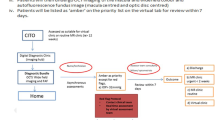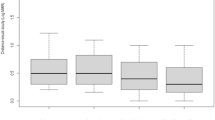Abstract
IT is well known that images stabilized against retinal tremor tend to fade from vision1,2, and it has been suggested that this indicates some form of fatigue or adaptation in the retinal receptors, which is normally relieved by small irregular displacements of the image. When using a simple stabilizing device3 for the study of complementary patterns4, I have observed a related effect which seems to require further, if not different, explanation.
This is a preview of subscription content, access via your institution
Access options
Subscribe to this journal
Receive 51 print issues and online access
$199.00 per year
only $3.90 per issue
Buy this article
- Purchase on SpringerLink
- Instant access to full article PDF
Prices may be subject to local taxes which are calculated during checkout
Similar content being viewed by others
References
Ditchburn, R. W., and Ginsborg, B. L., Nature, 170, 36 (1952).
Riggs, L. A., Ratcliff, F., Cornsweet, J. C., and Cornsweet, T. N., J. Opt. Soc. Amer., 43, 495 (1953).
MacKay, D. M., Nature, 180, 1145 (1957).
MacKay, D. M., Nature, 180, 849 (1957).
Ditchburn, R. W., and Fender, D. H., Opt. Act., 3, 128 (1955).
Author information
Authors and Affiliations
Rights and permissions
About this article
Cite this article
MACKAY, D. Monocular ‘Rivalry’ between Stabilized and Unstabilized Retinal Images. Nature 185, 834 (1960). https://doi.org/10.1038/185834a0
Issue date:
DOI: https://doi.org/10.1038/185834a0
This article is cited by
-
Registrierung von Augenbewegungen als Beitrag zur Untersuchung der Sehsch�rfe f�r bewegte Objekte
Albrecht von Graefes Archiv f�r Ophthalmologie Vereinigt mit Archiv f�r Augenheilkunde (1964)



